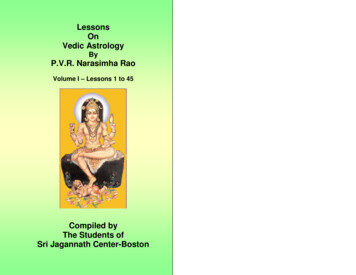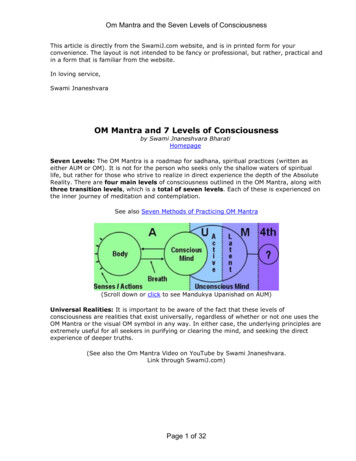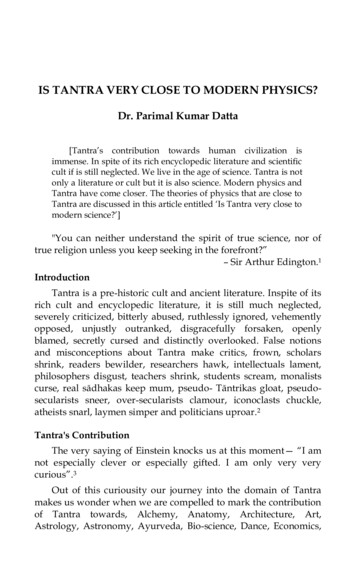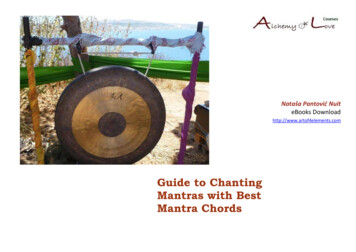
Transcription
THE HARE KRSNA. . .MAHA MANTRAEffects on Stress,Depression, andthe Three GunasDavid B. Wolf
ABSTRACTEFFECTS OF THE HARE KRSNA MAHA MANTRA ONSTRESS, DEPRESSION, AND THE THREE GUNASThe author conducted a 3-group study on the effects of chanting the hare krsnamaha mantra on stress, depression, and the three modes of nature- sattva, rajas, andtamas- described in the Vedas as the basis for human psychology. Sixty-two subjects,self-selected through newspaper advertisements in a Southeastern university town,completed the study. Average age was 24.63 years, with 31 males and 31 femalesparticipating. Stress was measured with the Index of Clinical Stress, depression wasmeasured with the Generalized Contentment Scale, and the modes of nature, or gunas,were measured with the Vedic Personality Inventory. Subjects were tested at pretest,posttest, and followup, with testing times separated by four weeks. Participants wererandomly assigned to a maha mantra group, an alternate mantra group, and a controlgroup. Subjects in each of the chanting groups chanted their mantra approximately 25minutes each day. The researcher concocted a mantra as the alternate mantra, thoughsubjects in the alternate group thought it was a genuine Vedic mantra. Primaryhypotheses of the study were based on Vedic theory, and stated that the maha mantragroup would increase sattva, and decrease stress, depression, rajas and tamas,significantly more than the other two groups. ANCOVA results, controlling for genderand age, supported these hypotheses at p .05 for all dependent variables except rajas,with effect sizes (eta2) for the four variables whose results supported the hypothesisranging from .21 to .33. The author suggests that the maha mantra has potential forutilization in clinical areas similar to those where other interventions of Eastern originhave been successful, such as treatment of stress, depression, and addictions. Further, itis recommended that the maha mantra be integrated into a spiritual approach to clientcare in social work and related fields. Suggestions for further research include applyingpath analysis to the data of this study to ascertain causal relationships, and applicationof Hierarchical Linear Models to the data to combine single-system analysis and groupanalytical methods for extracting the maximum amount of information. Additionally,further studies on the maha mantra are warranted, with various populations and invarious settings.Name: David Brian WolfDepartment: School of Social WorkMajor Professor: Dr. Neil AbellDegree: Doctor of PhilosophyTerm Degree Awarded: Summer, 19991
CHAPTER 1THEORETICAL BACKGROUNDThis dissertation focuses on a group experiment that was conducted on the effectsof chanting the hare krsna maha mantra, a mantra emphasized in the literature fromancient India for its efficacy in relieving stress, depression, and other mental healthdisturbances (Prabhupada, 1976). Therefore, chapter 1 presents some basic theoreticalconcepts, derived from the Eastern Vedic literatures, necessary for understanding theprocess of chanting mantras. chapter 2 contains a review of the literature on spiritualinterventions, a term which will be defined in chapter 1. The Vedas describe the HareKrsna maha mantra as a spiritually-based intervention for psychological upliftment(Prabhupada), and therefore it is appropriate to study related theory and literature onspiritual approaches to mental health improvement.Considering the person-in-environment orientation of the social work profession,spirituality and religion must be acknowledged and respected by social workers, as thesefactors are an integral part of practically every human culture, and they frequently play acentral role in the lives of many people. Canda (1988) emphasizes the importance forsocial workers to take into account the spiritual needs of clients so that the fullness of theclients’ human dignity and potential is recognized and respected in all helping situations.He asserts that spirituality is a basic aspect of human experience, both within and outsidethe context of religious institutions, and that it therefore should be explored more fullythrough social work practice, research, and theory building. In the United States, GallupPoll data consistently show that approximately 95% of the population believes in God,and about half the population is actively religious on at least a weekly basis (Paloutzian& Kirkpatrick, 1995). As the following literature review will show, religious and spiritualdimensions are among the most important cultural factors structuring human experience,beliefs, values, behavior, and illness patterns. It is justifiable, therefore, for helpingprofessionals to consider the religious and spiritual components of clients’ lives inattempts to serve the client population.Bullis (1996) writes “Traditionally, social work literature has reluctantlyaddressed religion’s or spirituality’s impact on clinical practice” (p. 6). He attributes thisto the historic rift between the religious and psychoanalytic movements, the allegedatheistic orientation of social workers, and economic, political, and professionalcompetition between religious professionals and secular social workers. Bullis continues“For the most part spirituality in social work literature is conspicuous only by itsabsence” (p. 6).If a multicultural perspective is to be more than a facade for social workers, thephenomena of religion and spirituality must be genuinely appreciated. The term“genuinely appreciated” is emphasized herein, since Western approaches to diversitysometimes involve a patronizing pseudo-respect meant to veil a proselytizing missionthat seeks to undermine long-held spiritual and religious beliefs and replace them with arelativistic viewpoint. Bellah et al. (1991) relate excerpts from a talk given a few yearsago by a student speaker at a Harvard University graduation:2
There is one experience that I believe we have all acquired during our career at thisfine institution, and that, ladies and gentlemen, in a word, is confusion. Thefreedom of our day is the freedom to devote ourselves to any values that wechoose, on the mere condition that we don’t believe them to be true. (pgs. 43-44)So, for social workers, whose profession has roots in spiritual and religioushumanitarianism (Dolgoff, Feldstein, & Skolnik, 1993), it may be a good idea toobjectively examine the literature on spirituality as it relates to the many facets of socialwork. To reject such literature as being non-scientific due merely to its content, withoutconsideration of its methodology and substantive results, may be considered dogmatism.Literature CategorizationThis paper will address the topic of spiritually-based interventions in the helpingprofessions, with a focus on the relevance of such interventions to the field of socialwork. Writings in this area will be classified into the following categories: generalrelevance of spirituality and religiosity to the helping professions; measurement ofspirituality; and spiritual interventions. General relevance of spirituality and religiosity tothe helping professions includes research pieces that investigate correlations betweenspiritual and religious factors and variables such as delinquency, management ofHIV/AIDS, hospice work, depression, self-esteem, and alcohol and drug use. Most ofthese studies incorporate quantitative designs, though there are a few qualitative piecesand some articles that primarily provide commentary on the topic. Measurement ofspirituality includes research articles that attempt to define and measure the construct ofspirituality utilizing psychometric procedures. The spiritual interventions section containsstudies and literature reviews that examine the effects of an intervention that is purportedto be spiritual in nature. These studies focus on spirituality as a specific intervention thatproduces effects on pre-defined dependent variables, whereas the general relevancearticles deal only with correlative relationships. The general relevance of spirituality andreligiosity to the helping professions category will be subdivided into two major sectionscommentary and empirical research. The spiritual interventions category will also besubdivided into three sections- empirical quantitative studies, empirical qualitativestudies, and literature reviews. This classification scheme is presented in Figure 1, andwill be further explained in the section entitled summary of literature classification.General relevance and measurement articles are presented as supportive materialto illustrate the importance and practicality of the spiritual component to the helpingprofessions. Articles in the spiritual interventions category will be comprehensivelyanalyzed and presented in Appendix A. Components of these research articles, such astheory, design, measurement and results, will be summarized and synthesized, and theliterature in the field will be reviewed and integrated with attention to gaps in theresearch.Spirituality and ReligiosityBullis (1996) states that “spirituality refers to the inner feelings and experiencesof the immediacy of a higher power” (p. 2), while religion refers to the “outward form ofbelief including rituals, dogmas and creeds, and denominational identity” (p. 2). Thus, theconcepts are related, though not interchangeable.3
To further explain, we will refer to Vedic philosophy, which constitutes theorientation of the author, as well as the basis for several of the interventions described inthis paper. According to the Vedas, “spiritual” refers to an energy that is transcendental togross and subtle forms of matter. Matter has gross forms, such as earth, water, air, andspace, and subtle forms, including mind and intelligence. Spiritual energy is distinct fromall these forms of matter. “Religion” refers to rituals, procedures, or institutions that aremeant, at least in principle, to facilitate access to spiritual experience. Obviously, thereare religious adherents who are not very spiritual, and spiritual persons who do notmanifest religious observance (Prabhupada, 1976).Though religion is not synonymous with spirituality- some might claim it isantonymous- studies on religiosity are included in this work because in the literature andin theory it is closely connected with spirituality and spiritual interventions. According tothe Srimad-Bhagavatam (Prabhupada, 1976), religion is meant to elevate one to aplatform of spirituality, beyond sectarian conceptions that are based in worldlydesignations. An example of such a conception is nationality. According to the Vedas, theself is a spiritual particle that is encased in a subtle and gross material body. If this bodyis born in America, then one may think “I’m American”, if born in Australia, one maythink “I’m Australian”, etc. However, these designations have no inherent connectionwith the spiritual self, only with the material covering. To further explain, if I’m riding ina Toyota, it would be a mistake to therefore conclude that I’m Japanese. Tomorrow I mayride in a Volkswagen, and then, based on bodily misidentification, I’d consider myselfGerman. Similarly, our bodies are material vehicles that have a purpose and should becared for properly, though it is illusion to consider the body to be the self. For furtherclarification of the distinction between the body and the non-material self, one may askoneself “Who is it that is thinking ‘I am the body’ or ‘I am an American’”? The entitythat is thinking is different than the body.Clearly, much of what passes as religion in the world today does not qualify asreligion based on the definition of Srimad-Bhagavatam. Still, religious institutions andpractices continue to serve as a major vehicle for people to achieve spirituality. In theliterature review that follows, this will become more evident. Therefore, many findingscorrelating religiosity and attributes of well-being are included in this paper.Bullis (1996) writes that “social workers are just beginning to define the nature ofspirituality in interventions” (p. 17), and reports that many conventional religiouspractices, such as prayer and scriptural reading, are used by social workers and othermental health professionals as interventions. For purposes of this dissertation, spiritualinterventions refer to religious practices or other observable techniques designed toimpact one’s spiritual experience.Epistemological Justificationfor Empirical Study of Spiritual InterventionsDawson (1997) asserts that spirituality cannot rightly be subsumed underempirical science. That is, spirituality should not be reduced to a conception that issubject, for instance, to the laws of thermodynamics, or is contingent on Einstein’sequation that relates energy and matter. This would be scientism, whereby spirit loses itstranscendence to matter and becomes subservient to empirical epistemologies. Dawsonmaintains that spirituality is a type of energy, but one not subject to empirical laws.4
Since this paper examines spiritual interventions, and the author does not viewspirituality as merely a component of material science, it may be questioned why we areinvestigating positivist research on spiritual topics, and why such research has been andshould be conducted. In response, it should be understood that science consists ofknowledge that can be reliably verified by systematic procedures of observation. Scienceis not necessarily limited to material subject matters. There are procedures employed inspiritual interventions that yield results that can be reliably assessed, and theseprocedures can be conceived as the basis for a spiritual science (Prabhupada, 1976).Empirical methods can be, and have been, extensively applied in the evaluation ofspiritual science and the effects of religious practice on psychosocial well-being. In fact,according to Levin, Larson, and Puchalski (1997), writing on the field of medicine,research on spiritual and religious factors is as sophisticated as any other area withinepidemiology, and findings have been subjected to greater scrutiny than most research.Material Science and the VedasKeefe (1996) comments “In the last thirty years, meditation began its marriage tothe rational-empirical tradition of Western science. In this most recent alliance it is beingtested, objectified, stripped of its mystical trappings, and enriched with empiricalunderstanding” (p. 434). Most of the meditative methods that are being tested, and thatwill be analyzed in this paper, are based in Vedic theory and practices. This illustrateshow a spiritual theory with concomitant praxes can be dovetailed with empirical science.Empirical support for these methods, in areas such as decreasing depression, stress andsubstance abuse, may strengthen the scientific basis of Vedic theory.Though the ultimate goal of Vedic science is realization of our spiritual nature,there is a vast material component in Vedic science. Vedic material science is based onthe three gunas, or modes of nature- sattva, rajas, and tamas. Characteristics of eachmode are extensively described in Vedic literature, and these descriptions formoperational definitions for experimental science. For instance, a characteristic of tamasguna is depression, whereas sattva guna is symptomized by a feeling of happiness(Dasgupta, 1961). According to Vedic theory, practice of a meditative process, such aschanting of certain sound vibrations, will diminish the effects of tamas, and augment theinfluence of sattva. Thus, guna theory is conducive for empirical investigation, in thiscase by standardized psychometric tools for assessment of depression and happiness.Much work needs to be done, however, to further operationalize Vedic concepts andformulate and implement research designs.Assumptions Derived from Vedic TheoryBefore concluding the introduction it is appropriate to elaborate on Vedic theory,especially as it relates to social science, because this is the world view of the author, andthe reader will therefore be better equipped to critique and understand this paper with anappreciation of Vedic concepts. This presentation is not meant to be a comprehensivedefense of Vedic assertions. The main purpose is to acquaint the reader with the beliefs ofthe author, and to prepare the reader for what follows. This explication of Vedicphilosophy will use as a framework Burrell’s and Morgan’s (1979) four criteria forassessing a social science theory. These criteria are ontology, epistemology, humannature and methodology.5
Ontologically, social science approaches can be placed on a continuum withrealism and nominalism at the extremes. Nominalists deny that social structures are real,and assert that reality is a subjective phenomena, while realists insist that social structuresexist as empirical entities (Burrell & Morgan, 1979). For Vaisnavas, adherents of Vedicphilosophy and culture, creation, consisting of material and spiritual aspects, is real. Thisrealism is countered, however, by the understanding that persons in materialconsciousness, who comprise almost everyone in this world, falsely perceive realityaccording to the illusory conceptions that pervade their mind and intelligence. TheVaisnava social scientist, therefore, acknowledges the importance of subjectivity instudying and interacting with people, since subjective understandings are the subtle forcethat drives human interaction. Another caveat to regarding Vaisnavas as realists is thetheological notion that reality is a manifestation of the consciousness of God. In thissense, Vaisnavas may be considered as radical subjectivists (Prabhupada, 1975).Epistemologically, social scientists can be placed on the continuum from antipositivism to positivism. Positivist epistemologies, which dominate the natural sciences,search for regularities and causal relationships in the social world. Anti-positivists preferto view social science as a subjective undertaking, and concentrate on comprehending theexperience of the individual, rather than discovering objective laws governing interaction(Burrell & Morgan, 1979). Vedic epistemology includes a branch, called anumana, that isequivalent to the process of modern empirical science. Anumana involves acquiringknowledge through sensory observations that are then processed, analyzed, and organizedinto theories by the mind and intelligence. These theories are then tested by furtherobservations. Though the Vedas accept this as a possible approach to knowledge, theyalso describe the shortcomings of this system. A major drawback of this method is that itis based on the mind and senses, which are imperfect in several ways. For instance, oursenses make mistakes, and thus we have erasers on pencils. The senses are susceptible toillusion, and therefore we may confuse a rope for a snake. Additionally, our senses arevery limited. Though we can’t see what’s happening two inches behind our head, andhave a difficult time remembering what we were doing at this time two weeks ago, weconjecture, based on empiric data, what happened thousands of light years away, billionsof years ago (Gosvami, 1977).The Vedas describe knowledge as innate to the self. This knowledge is covered,and Vedic social science seeks to extricate the self from this covering. Towards this goal,positivist and anti-positivist approaches may be used, though utilization does not negateinherent flaws of a method (Prabhupada, 1975).With regards to this dissertation, there is no internal contradiction in studying anddiscussing Vedic concepts and methods using positivist approaches. Empirical methodsare condoned by the Vedas, though the Vedas also critique them. Several otherepistemological systems, along with their uses and deficiencies, are also elaborated in theVedic literatures. Exposition of these systems is beyond the scope of this paper, and thisshort presentation is included to justify the use of empirical methodologies within aVedic context.Voluntarism versus determinism forms another debate amongst social sciencetheorists. Voluntarists accept the free will of the human being, whereas deterministsbelieve that a person’s actions are caused by environmental factors (Burrell & Morgan,1979). Vaisnavas view the self as possessing free will. However, the capacity for selfdetermination, which stems from the spiritual entity that is the actual self, is covered by6
the material energy. To the extent that the self is covered by the modes of material nature,or gunas, free will cannot manifest. Thus, the human situation involves a mixture ofdeterministic and voluntaristic forces. Circumstances of birth provide boundaries, withinthe material sphere of activities, for the self, though free will remains active. A Vedicsocial worker assists the self to make the best choices from available options(Prabhupada, 1976).Methodologically, social science research techniques include qualitative andquantitative methods. Quantitative techniques tend to be compatible with realist,positivist and determinist approaches (Heineman, 1981). From the Vaisnava vantagepoint, quantitative techniques are increasingly useful as the object of study possesses lessconsciousness. Thus, a positivist, quantitative research design would be more effectivestudying rocks than animals, and less effective when studying human beings, due to therelatively high degree of consciousness in humans. Consciousness means free will, andconsciousness is considered to be a symptom of the spiritual energy. When free willenters the equation, predictive capacity of the scientist decreases. Hence, social sciencesare less exact than hard sciences such as chemistry and physics. Still, material naturecovers the free will of humans to a large extent, and therefore the Vaisnava socialscientist can utilize quantitative methods for researching social interaction and theactivities of the mind and intelligence (Prabhupada, 1976). By employing quantitativeapproaches, the social scientist is implicitly expressing deterministic assumptions aboutthe person(s) being studied. The following section examines selection and classificationprocedures for analysis of research articles on spiritual topics.Scope of the Present StudyConsidering the concepts described above, we will study the effects of the mahamantra on variables such as stress, depression, and the three gunas. Prior to discussingthe experiment on the maha mantra, there will be a literature review on correlationsbetween spiritual and religious factors with indicators of mental and physical health, andon the effects of spiritual and religious interventions. This literature review will alsoinclude a discussion of the literature on psychometric attempts to measure spirituality.After the literature is reviewed and synthesized, the methodology for the groupexperiment on the maha mantra will be discussed. Then, in chapter 4, results from themaha mantra study will be analyzed, with regards to differential effects on dependentvariables between persons who chanted the maha mantra and persons who chanted analternate mantra, as well as with persons who did not chant any mantra. Additionally, asingle-system design pilot study of the maha mantra, which was conducted prior to thegroup experiment, will be described in the appendices. Chapter 5 will discuss the resultsof the group study, especially as they relate to the theoretical presentations of thischapter, and the literature review of chapter 2.7
CHAPTER 2LITERATURE REVIEW AND SYNTHESISSelection ProceduresFour databases- PsychInfo, Medline, PsycLIT, and Sociofile- were searched forthis systematic research synthesis. In these databases, the following keywords, alone andin combinations, were used: meditation, mantra, prayer, faith, spirituality, religion,health, stress, anxiety, depression, and social work.Klein and Bloom (1994) delineate five major types of articles in the social workliterature- empiricism, technology, conceptualization, valuation and commentary. Ofthese, the empiricism, technology, and commentary categories are relevant to theclassification system of this paper. Empiricism, according to Klein and Bloom (1994):refers to activities of engaging the world and people in it by means of the fivebasic senses. The empirical component includes planned actions to observe andmeasure social events in laboratories, clinics, or community settings- what wouldbe termed‘research’ or ‘evaluation’ in the current literature. (p. 422)The categorization scheme of Klein and Bloom (1994) will be further described inthe categorization overview section of this chapter. For now, the categories areintroduced to help the reader understand the discussion of selection procedures thatfollows.For the general relevance of spirituality and religiosity to the helping professionscategory (see Figure 1), commentary and empirical research articles that examined theimportance of spirituality and religiosity to fields such as social work, mental health andmedicine were sought. There are many such articles, and the 43 pieces chosen forinclusion in this section are by no means exhaustive. The main point of the generalrelevance section is to demonstrate that spirituality and religiosity are consideredimportant factors for helping professionals. Therefore, variety in articles was stressed toillustrate the pervasive nature of these factors. If several articles covered the same topic,the most recent ones were chosen for inclusion. The main criterion for inclusion wasdiversity, with respect to population and professional area. For example, the studiesselected examine the role of spiritual and religious factors in areas such as chronic illness,life satisfaction, attributes of caregivers in Alzheimer’s disease, death depression andanxiety, predictors of mortality, alcohol and drug use, management of HIV/AIDS,depression, delinquency, self-esteem, crime, hospice work, coping with war, generalwell-being, coping with a chronically ill child, resolving childhood abuse issues, suicide,and dealing with illnesses such as cancer and heart disease. Populations studied includeadolescents, African Americans, elderly, long-term hospital inpatients, burn patients,mental health clients, suicidal persons, and hospice workers.Not all articles in this section provide evidence for the potential importance ofspirituality and religiosity, though the great majority of them do. Selection of empiricalresearch articles in this category was based on title, to check for substantive area andpopulation, and date, as described above. That is, results were not analyzed prior toselection. This methodology was incorporated to reduce selection bias. Commentaryarticles in this category were selected after the empirical research articles, in order to8
provide some theoretical framework that bridged a variety of fields, including socialwork, nursing, medicine, psychology, and psychiatry. Though more than the eightcommentary articles included herein were found, none of these articles argued for theunimportance of spirituality and religiosity, and thus the tenor of the commentary articlescan also be considered representative of the literature.Articles in the measurement of spirituality section (see Figure 1) focus onquantitative empirical research on the measurement of spirituality. These studies focus onattempts to directly measure spirituality, rather than correlates of spirituality, such asgeneral well-being. Three spirituality instruments are analyzed. The Spiritual Well-BeingScale (SWBS) is the most widely researched and utilized tool in the field, and is basedon Judeo-Christian psychological theory (Ellison & Smith, 1991). Based on Vedic gunatheory, the Vedic Personality Inventory (VPI) is the guna scale that has been mostextensively analyzed with psychometric methods (Wolf, 1998). Hatch, Hellmich,Naberhaus, and Berg (1995) have developed the Spiritual Involvement and Beliefs Scale(SIBS), which is an attempt, derived from dissatisfaction with the SWBS, to assessspirituality without Western bias.Articles in the spiritual interventions category (see Figure 1) constitute the maintopic of this literature review. Included are articles that examine interventions thatpurport to be spiritual in nature, with regard to their effects on dependent variables suchas depression, stress, and substance abuse recovery. This review focuses on the content ofthe interventions, as well as the methodological rigor of the studies. The prime selectioncriteria was diversity that reflects the heterogeneity of interventions and methodologies.Using this criteria, articles investigating the effects of Western-style prayer, AlcoholicsAnonymous non-sectarian spirituality, social work community interventions, andEastern-style meditation were chosen. Only in the area of Eastern-style meditation werethere many articles, necessitating further selection criteria. Delmonte (1983) andDelmonte and Kenny (1985) conducted literature reviews on Eastern-style spiritualinterventions, and these reviews are included in this analysis as a summary of research inthis area prior to 1985. For research on Eastern-style interventions since 1985, selectionsincluded studies with a variety of research techniques, especially with regards toqualitative and quantitative approaches, and studies that investigated a range ofinterventions, such as mantra-based, Buddhist, and physical yoga techniques.Categorization OverviewExcept for the commentary articles in the general relevance category, allliterature classified in Figure 1 fits the definition for empiricism given by Klein andBloom (1994), which is presented above in the section on selection procedures. For thespecific purposes of this paper, general relevance, spiritual interventions, andmeasurement of spirituality categories have been differentiated. For the general relevancecategory, commentary and empirical research sub-categories have been created, and forthe spiritual interventio
the Srimad-Bhagavatam (Prabhupada, 1976), religion is meant to elevate one to a platform of spirituality, beyond sectarian conceptions that are based in worldly designations. An example of such a conception is nationality. According to the Vedas, the self is a spiritual particle that is encased in a subtle and gross material body. If this body










